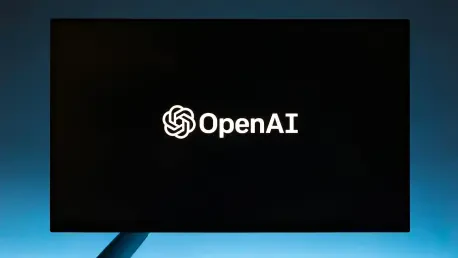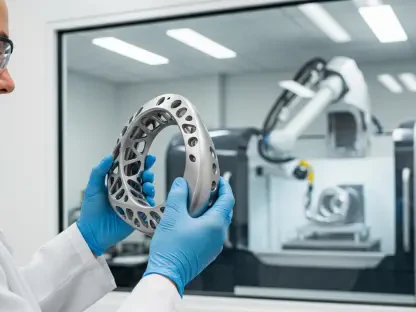Setting the Stage for a Semiconductor Revolution
In a world where artificial intelligence is reshaping industries at an unprecedented pace, the demand for cutting-edge computing power has never been more critical. Imagine a future where AI systems process data at scales unimaginable today, driving innovations in healthcare, finance, and beyond with remarkable speed and efficiency. This vision is coming closer to reality with the recently announced partnership between AMD, a semiconductor powerhouse, and OpenAI, a leader in AI research. Unveiled on Monday, this collaboration positions AMD to supply its advanced Instinct MI450 graphics chips to fuel OpenAI’s ambitious AI infrastructure goals. This market analysis explores the implications of this alliance, diving into current trends in the AI and semiconductor sectors, forecasting potential shifts by 2026, and offering strategic insights for stakeholders navigating this dynamic landscape.
Unpacking Market Trends and Competitive Dynamics
Rising Demand for AI Computing Power
The AI sector is experiencing explosive growth, with computational needs doubling roughly every few months for advanced models like those powering generative AI tools. This insatiable appetite for processing power has turned semiconductors into the backbone of technological progress, creating a market projected to exceed $500 billion by the end of this decade. OpenAI’s plan to deploy 1 gigawatt of computing capacity by the second half of 2026, with an ultimate target of 6 gigawatts, underscores the scale of infrastructure required. Such ambitious goals highlight a broader industry trend: AI companies are racing to secure hardware capable of supporting next-generation systems, pushing chipmakers to innovate rapidly while grappling with supply chain constraints.
Shifting Alliances in the Semiconductor Space
Historically, Nvidia has dominated the AI chip market, commanding over 80% of the share and achieving the status of the world’s most valuable company during the AI boom. However, OpenAI’s strategic pivot to partner with AMD signals a significant shift in competitive dynamics. By integrating AMD’s Instinct MI450 chips into its infrastructure, OpenAI aims to diversify its supply chain, reducing reliance on a single provider amid potential shortages and geopolitical tensions affecting global chip production. This move not only challenges Nvidia’s stronghold but also elevates AMD’s position in high-performance computing, potentially reshaping market shares and investor confidence as evidenced by a 25% surge in AMD’s stock price post-announcement.
Financial Structures Redefining Partnerships
A unique facet of this deal lies in its financial innovation, setting a precedent for future tech collaborations. OpenAI holds the option to acquire up to a 10% stake in AMD, equivalent to 160 million shares, through a warrant tied to milestones such as computing power deployment and AMD’s share price targets. This arrangement aligns the long-term interests of both entities, incentivizing performance while embedding a shared stake in success. Unlike traditional supplier contracts, this model introduces a layer of financial synergy, though it carries risks like market volatility or unmet targets delaying the warrant’s vesting. If successful, this structure could inspire similar arrangements across the industry, blending capital investment with technological cooperation.
Forecasting the Future of AI Hardware by 2026
Technological Advancements on the Horizon
Looking toward 2026, the AMD-OpenAI partnership is poised to catalyze significant advancements in chip design tailored for AI workloads. AMD’s focus on integrating AI-specific architectures into its Instinct series suggests a potential redefinition of performance benchmarks, challenging competitors to accelerate their innovation cycles. Industry projections indicate that energy efficiency and cooling technologies will become critical differentiators, as data centers supporting AI systems face mounting pressure to manage power consumption. The collaboration’s success could hinge on AMD’s ability to scale production without compromising quality, setting a new standard for hardware reliability in high-stakes AI applications.
Market Implications and Competitive Pressures
The broader market implications of this alliance extend beyond immediate hardware supply, potentially eroding Nvidia’s dominance if AMD consistently delivers on its promises. Analysts anticipate that by 2026, strategic partnerships between AI firms and chipmakers will become commonplace, driven by the need to navigate supply chain complexities and regulatory landscapes. Governments worldwide are increasingly scrutinizing semiconductor production and energy usage, which could introduce compliance costs or restrictions affecting deployment timelines. For AMD, securing a foothold in OpenAI’s infrastructure offers a chance to capture a larger slice of the AI hardware market, estimated to grow by double-digit percentages annually over the next few years.
Sustainability Challenges in Scaling Infrastructure
A critical factor shaping the future is the sustainability of scaling AI infrastructure to meet global demand. OpenAI’s target of 6 gigawatts of computing power raises concerns about energy consumption, particularly in data center-heavy regions like the United States and Europe. Industry experts emphasize that advancements in chip efficiency and renewable energy integration will be essential to mitigate environmental impacts and avoid regulatory backlash. Misconceptions persist that AI progress relies solely on faster hardware; in reality, it demands a holistic approach encompassing software optimization, infrastructure readiness, and power management. This partnership must address these multifaceted challenges to ensure long-term viability in a resource-constrained world.
Reflecting on Strategic Insights and Next Steps
Looking back, the partnership between AMD and OpenAI stood as a pivotal moment in the AI and semiconductor industries, highlighting the urgent need for scalable computing resources and innovative collaboration models. The deal’s blend of technological ambition and financial ingenuity offered a glimpse into how strategic alliances could reshape competitive landscapes. For businesses and investors, the key takeaway was the importance of diversifying supply chains and investing in partnerships that balanced risk with opportunity. Moving forward, stakeholders should prioritize building resilient ecosystems by exploring alternative hardware suppliers and advocating for sustainable practices in AI infrastructure development. Monitoring regulatory shifts around energy usage and chip production would also be crucial to staying ahead in an evolving market. Ultimately, this collaboration paved the way for reimagining how technology and strategy intertwined to address the boundless potential of artificial intelligence.









